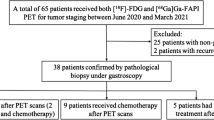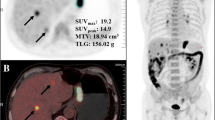Abstract
Purpose
We prospectively investigated the feasibility of 3′-deoxy-3′-18F-fluorothymidine (FLT) positron emission tomography (PET) for the detection of gastric cancer, in comparison with 2-deoxy-2-18F-fluoro-d-glucose (FDG) PET, and determined the degree of correlation between the two radiotracers and proliferative activity as indicated by Ki-67 index.
Methods
A total of 21 patients with newly diagnosed advanced gastric cancer were examined with FLT PET and FDG PET. Tumour lesions were identified as areas of focally increased uptake, exceeding that of surrounding normal tissue. For semiquantitative analysis, the maximal standardized uptake value (SUV) was calculated.
Results
For detection of advanced gastric cancer, the sensitivities of FLT PET and FDG PET were 95.2% and 95.0%, respectively. The mean (±SD) SUV for FLT (7.0 ± 3.3) was significantly lower than that for FDG (9.4 ± 6.3 p < 0.05). The mean FLT SUV and FDG SUV in nonintestinal tumours were higher than in intestinal tumours, although the difference was not statistically significant. The mean (±SD) FLT SUV in poorly differentiated tumours (8.5 ± 3.5) was significantly higher than that in well and moderately differentiated tumours (5.3 ± 2.1; p < 0.04). The mean FDG SUV in poorly differentiated tumours was higher than in well and moderately differentiated tumours, although the difference was not statistically significant. There was no significant correlation between Ki-67 index and either FLT SUV or FDG SUV.
Conclusion
FLT PET showed as high a sensitivity as FDG PET for the detection of gastric cancer, although uptake of FLT in gastric cancer was significantly lower than that of FDG.


Similar content being viewed by others
References
Hustinx R, Bénard F, Alavi A. Whole-body FDG-PET imaging in the management of patients with cancer. Semin Nucl Med 2002;32:35–46.
Bomanji JB, Costa DC, Ell PJ. Clinical role of positron emission tomography in oncology. Lancet Oncol 2001;2:157–64.
Yeung HW, Macapinlac H, Karpeh M, Finn RD, Larson SM. Accuracy of FDG-PET in gastric cancer. Preliminary experience. Clin Positron Imaging 1998;1:213–21.
Stahl A, Ott K, Weber WA, Becker K, Link T, Siewert JR. FDG PET imaging of locally advanced gastric carcinomas: correlation with endoscopic and histopathological findings. Eur J Nucl Med Mol Imaging 2003;30:288–95.
Mochiki E, Kuwano H, Katoh H, Asao T, Oriuchi N, Endo K. Evaluation of 18F-2-deoxy-2-fluoro-D-glucose positron emission tomography for gastric cancer. World J Surg 2004;28:247–53.
Chen J, Cheong JH, Yun MJ, Kim J, Lim JS, Hyung WJ. Improvement in preoperative staging of gastric adenocarcinoma with positron emission tomography. Cancer 2005;103:2383–90.
Yamada A, Oguchi K, Fukushima M, Imai Y, Kadoya M. Evaluation of 2-deoxy-2-[18F]fluoro-D-glucose positron emission tomography in gastric carcinoma: relation to histological subtypes, depth of tumor invasion, and glucose transporter-1 expression. Ann Nucl Med 2006;20:597–604.
Mukai K, Ishida Y, Okajima K, Isozaki H, Morimoto T, Nishiyama S. Usefulness of preoperative FDG-PET for detection of gastric cancer. Gastric Cancer 2006;9:192–6.
Tian J, Chen L, Wei B, Shao M, Ding Y, Yao S. The value of vesicant 18F-fluorodeoxyglucose positron emission tomography (18F-FDG PET) in gastric malignancies. Nucl Med Commun 2004;25:825–31.
Yoshioka T, Yamaguchi K, Kubota K, Saginoya T, Yamazaki T, Ido T. Evaluation of 18F-FDG PET in patients with advanced, metastatic, or recurrent gastric cancer. J Nucl Med 2003;44:690–9.
Shreve PD, Anzai Y, Wahl RL. Pitfalls in oncologic diagnosis with FDG PET imaging: physiologic and benign variants. Radiographics 1999;19:61–77.
Koga H, Sasaki M, Kuwabara Y, Hiraka K, Nakagawa M, Abe K. An analysis of the physiological FDG uptake pattern in the stomach. Ann Nucl Med 2003;17:733–8.
Shields AF, Grierson JR, Dohmen BM, Machulla HJ, Stayanoff JC, Lawhorn-Crews JW. Imaging proliferation in vivo with [F-18]FLT and positron emission tomography. Nat Med 1998;4:1334–6.
Rasey JS, Grierson JR, Wiens LW, Kolb PD, Schwartz JL. Validation of FLT uptake as a measure of thymidine kinase-1 activity in A549 carcinoma cells. J Nucl Med 2002;43:1210–7.
Francis DL, Freeman A, Visvikis D, Costa DC, Luthra SK, Novelli M. In vivo imaging of cellular proliferation in colorectal cancer using positron emission tomography. Gut 2003;52:1602–6.
van Westreenen HL, Cobben DC, Jager PL, van Dullemen HM, Wesseling J, Elsinga PH. Comparison of 18F-FLT PET and 18F-FDG PET in esophageal cancer. J Nucl Med 2005;46:400–4.
Buck AK, Halter G, Schirrmeister H, Halter G, Möller P, Kratochwil C. Imaging proliferation in lung tumors with PET: 18F-FLT versus 18F-FDG. J Nucl Med 2003;44:1426–31.
Dittmann H, Dohmen BM, Paulsen F, Eichhorn K, Eschmann SM, Horger M. [18F]FLT PET for diagnosis and staging of thoracic tumours. Eur J Nucl Med Mol Imaging 2003;30:1407–12.
Herrmann K, Ott K, Buck AK, Loedick F, Wilhem D, Souvatzoglou M. Imaging gastric cancer with PET and the radiotracers 18F-FLT and 18F-FDG: a comparative analysis. J Nucl Med 2007;48:1945–50.
Machulla HJ, Blocher A, Kuntzsch M, Grierson JR. Simplified labeling approach for synthesizing 3′-deoxy-3′-[18F]fluorothymidine ([18F]FLT). J Radioanal Nucl Chem 2000;24:843–6.
Toorongian SA, Mulholland GK, Jewett DM, Bachelor MA, Kilbourn MR. Routine production of 2-deoxy-2-[18F]fluoro-D-glucose by direct nucleophilic exchange on a quaternary 4-aminopyridinium resin. Nucl Med Biol 1990;17:273–9.
Hamilton SR, Aaltonen LA. Tumours of the stomach. WHO classification of tumours. Pathology and genetics of tumours of the digestive system. Lyon: IARC Press; 2000. p. 38–52.
Francis DL, Visvikis D, Costa DC, Arulampalam TH, Townsend C, Luthra SK. Potential impact of [18F] 3′-deoxy-3′-fluorothymidine versus [18F]fluoro-2-deoxy-D-glucose in positron emission tomography for colorectal cancer. Eur J Nucl Med Mol Imaging 2003;30:988–4.
Yap C, Vranjesevic D, Cameron R, Czernin J. F18-fluorine-thymidine; a new molecular probe for PET imaging of cancer (abstract). Ann Surg Oncol 2003;10:S38.
Cobben DC, van der Laan BF, Maas B, Vaalburg W, Suurmeijer AJ, Hoekstra HJ. 18F-FLT PET for visualization of laryngeal cancer: comparison with 18F-FDG PET. J Nucl Med 2004;45:226–31.
Smyczek-Gargya B, Fersis N, Dittmann H, Vogel U, Reischl G, Machulla HJ. PET with [18F]fluorothymidine for imaging of primary breast cancer: a pilot study. Eur J Nucl Med Mol Imaging 2004;31:720–4.
Costa A, Silvestrini R, Mochen C, Legiaglie C, Boracchi P, Faramda A. P53 expression, DNA ploidy and S-phase cell fraction in operable locally advanced non-small-cell lung cancer. Br J Cancer 1996;73:914–9.
Konishi T, Miyama T, Sakamoto S, Hirata T, Mafune K, Hiraishi M. Activities of thymidylate synthetase and thymidine kinase in gastric cancer. Surg Oncol 1992;1:215–21.
Scholzen T, Gerdes J. The Ki-67 protein: from the known and the unknown. J Cell Physiol 2000;182:311–22.
Spyratos F, Ferrero-Poüs M, Trassard M, Hacène K, Phillips E, Tubiana-Hulin M. Correlation between MIB-1 and other proliferation markers: clinical implications of the MIB-1 cutoff value. Cancer 2002;94:2151–9.
Schwartz JL, Tamura Y, Jordan R, Grierson JR, Krohn KA. Monitoring tumor cell proliferation by targeting DNA synthetic processes with thymidine and thymidine analogs. J Nucl Med 2003;44:2027–32.
Munch-Petersen B, Cloos L, Jensen HK, Tyrsted G. Human thymidine kinase 1. Regulation in normal and malignant cells. Adv Enzyme Regul 1995;35:69–89.
Munch-Petersen B, Tyrsted G, Cloos l. Reversible ATP-dependent transition between two forms of human cytosolic thymidine kinase with different enzyme properties. J Biol Chem 1993;268:15621–5.
Barthel H, Cleuj MC, Collingridge DR, Hutchinson OC, Osman S, He Q. 3′-deoxy-3′-[18F]fluorothymidine as a new marker for monitoring tumor response to antiproliferative therapy in vivo with positron emission tomography. Cancer Res 2003;63:3791–8.
Dimitrakopoulou-Strauss A, Strauss LG. The role of 18F-FLT in cancer imaging: does it really reflect proliferation? Eur J Nucl Med Mol Imaging 2008;35:523–6.
Ott K, Herrmann K, Lordick F, Wieder H, Weber WA, Becker K. Early metabolic response evaluation by fluorine-18 fluorodeoxyglucose positron emission tomography allows in vivo testing of chemosensitivity in gastric cancer: long-term results of a prospective study. Clin Cancer Res 2008;14:2012–8.
Author information
Authors and Affiliations
Corresponding author
Rights and permissions
About this article
Cite this article
Kameyama, R., Yamamoto, Y., Izuishi, K. et al. Detection of gastric cancer using 18F-FLT PET: comparison with 18F-FDG PET. Eur J Nucl Med Mol Imaging 36, 382–388 (2009). https://doi.org/10.1007/s00259-008-0970-3
Received:
Accepted:
Published:
Issue Date:
DOI: https://doi.org/10.1007/s00259-008-0970-3




